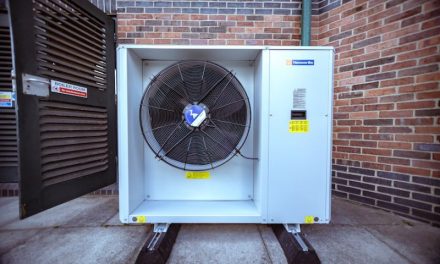 Due to the often stressful conditions that centrifugal process pumps have to operate in, it is not uncommon for them to fail prematurely. However, ensuring that they operate at optimum speed and efficiency can improve reliability, reduce maintenance and lower energy consumption. Brammer UK’s Jeremy Salisbury explains
Due to the often stressful conditions that centrifugal process pumps have to operate in, it is not uncommon for them to fail prematurely. However, ensuring that they operate at optimum speed and efficiency can improve reliability, reduce maintenance and lower energy consumption. Brammer UK’s Jeremy Salisbury explains
There are a variety of problems associated with centrifugal pump operation – a common example being cavitation, which is a significant cause of wear, especially in pumps required to start quickly. When a liquid undergoes rapid pressure changes, cavities form in its lower pressure regions. When entering high pressure areas, these bubbles collapse, causing cyclic stressing and, ultimately, surface fatigue to the impeller, pump housing, or both.
Also of concern is rapid pump stoppage or failure. A sudden flow reduction can mean a valve closes rapidly, resulting in water hammer – a pressure surge or wave which can cause noise, vibration, blown valves, leaks, and pipe collapse.
In addition, vibration from component wear or misaligned and poorly balanced shafts can increase energy usage and maintenance costs, and even cause product failure.
Speed control
Variable speed drives (VSDs) can reduce energy usage and help optimise reliability while closing the loop with regard to PID (proportional-integral-derivative) functionality.
A VSD which reduces by ten percent the speed of a 22kW pump operating 24 hours a day for 300 days annually, can pay for itself through reduced energy usage in just eight months, depending on electricity costs.
Energy is key given that many pumps are specified larger than needed for the application. A small speed increase to up flow rate can potentially increase power demand significantly, meaning contingencies are successively built into the design process. However, a VSD delivering a four percent speed decrease typically pays for itself in around two years through reduced energy costs.
The only rider is that VSDs cannot be fitted to pumps operating under high head pressures. This is because pressure varies in proportion to speed as per the pump affinity laws. In these cases, speed variation using any method is not advisable without due caution.
Other options include v-belts, where potential issues like slippage have been largely circumvented by the latest synchronous belts, which do not require regular retensioning. Meanwhile, the latest synchronous carbon belts offer far greater power carrying capacity than was previously achievable and exceptional flex fatigue resistance, meaning they bend more easily around pulleys and deliver a typical five percent energy efficiency advantage over v-belt drives.
VSD or soft-start?
A VSD is generally preferable for smaller pumps, while soft-start typically becomes economical for 22kW pumps or larger. However, there is a cross-over where either method is suitable depending on application requirements. For example, an application starting once per month and running at constant speed will require soft-start, however, a VSD will be more appropriate if demand from the pump varies.
Performance can also be increased by fitting pressure sensors in applications with variable throughput. The sensor will feed back any reduced flow requirement to the VSD which will cause the motor to slow accordingly, delivering energy savings with no risk to the pump.
Combating ragging
The fouling of impellers, or ‘ragging’, can significantly affect pump performance. It can cause partial or complete blockage, with problems of down-time extending over several days. Cleaning costs also have to be considered and back-up systems are placed under additional pressure and, in the worst cases, effluent leakage can result.
This can be negated by an intelligent pump control system which monitors overall performance, triggering an automated cleansing cycle if performance crosses pre-programmed ‘out of profile’ boundaries.
Condition monitoring
Identifying problems before they occur is integral to optimising efficiency and minimising down-time. Modern condition monitoring systems such as sensors and accelerometers monitor vibration levels and temperature changes with information downloadable to a handheld system or, for remote or hard to access locations, fed into a central system which can provide warnings of unusual or undesirable readings, allowing planned maintenance if required. Modern software tools even suggest likely causes, and prescribed remedial actions, based on the data provided.
Pro-active maintenance
Pumps should always operate on a stable baseplate with shafts optimally aligned and lubricated according to manufacturer instructions, otherwise poor performance and ultimately failure are almost inevitable. As with any other component, replacing parts without investigation into the problem’s root cause will not re-establish optimum performance.
The following points should be checked monthly. Priming speed, capacity, noise in the pump casing, gaskets and O-rings, shaft seal leakage of air and water, hose, hose washers and suction strainer. Six monthly checks should be made of impeller wear, clearance between the impeller face and the volute, shaft seal wear and shaft sleeve wear, while the casing and volute passages should also be cleaned.
This combination of regular checks and pro-active maintenance, coupled with appropriate control methods, will contribute significantly towards optimising efficiency, minimising down-time and reducing whole life costs.




